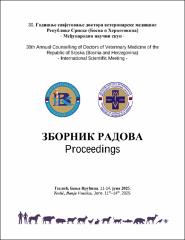| dc.contributor.author | Vidaković Knežević, Suzana | |
| dc.contributor.author | Vranešević, Jelena | |
| dc.contributor.author | Knežević, Slobodan | |
| dc.contributor.author | Dončić, Stefan | |
| dc.contributor.author | Milanov, Dubravka | |
| dc.contributor.author | Kartalović, Brankica | |
| dc.contributor.author | Novakov, Nikolina | |
| dc.date.accessioned | 2025-07-16T11:52:59Z | |
| dc.date.available | 2025-07-16T11:52:59Z | |
| dc.date.issued | 2025-06-11 | |
| dc.identifier.uri | https://repo.niv.ns.ac.rs/xmlui/handle/123456789/1001 | |
| dc.description.abstract | The Food Safety Law requires food business operators to ensure that the food they place on the market is safe. The absence of visible parasites in fishery products is one of the requirements. After ingestion, parasites present in fishery products can cause infections in humans. The nematode Anisakis spp. is one of the most common parasites associated with the consumption of fish products, and causes anisakiasis, a digestive tract disorder with nonspecific symptoms or an allergic reaction. By visual inspection of the whole fish, Anisakis spp. larvae, cocooned in a spiral shape, 4 to 5 mm in diameter, can be easily observed. The aim of this research is to highlight the significant risks to human health caused by the fishery products infected with parasites. The visual examination of 202 samples of imported fishery products, from January 2023 to March 2025, revealed the presence of visible parasites in 17.83%. Parasites were present in samples of white fish and blue fish, including hake (Merluccius hubbsi and Merluccius productus) (10.89%), Atlantic mackerel (Scomber scombrus) (5.94%), Atlantic chub mackerel (Scomber colias) (0.50%) and herrings (Clupea). Fishery products that are visibly infected with parasites must be frozen or heat-treated to kill live parasites that pose a risk to human health. Since the presence of parasites causes consumer disgust and affects sensory properties, and in addition, allergic reactions may occur due to the ingestion of live or dead parasites, competent authorities and food business operators should conduct continuous risk analysis to reduce risks to consumer health. | en_US |
| dc.description.sponsorship | This study was funded by the Ministry of Science, Technological Development and Innovation of Republic of Serbia (Contract No: 451-03-136/2025-03/20003). | en_US |
| dc.language.iso | sr | en_US |
| dc.publisher | Veterinarska komora Republike Srpske, Banja Luka | en_US |
| dc.source | Zbornik radova, 30. Godišnje savjetovanje doktora veterinarske medicine Republike Srpske (Bosna i Hercegovina), Teslic | en_US |
| dc.subject | biological hazard | en_US |
| dc.subject | parasites | en_US |
| dc.subject | fishery products | en_US |
| dc.subject | consumer health. | en_US |
| dc.title | Proizvodi ribarstva invadirani parazitima kao rizik za zdravlje ljudi | en_US |
| dc.title.alternative | Fishery products infected by parasites as a human health risk | en_US |
| dc.type | Conference paper | en_US |
| dc.citation.spage | 45 | en_US |
| dc.citation.epage | 46 | en_US |
| dc.citation.rank | M64 | en_US |
| dc.type.version | published | en_US |

